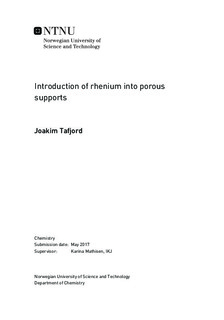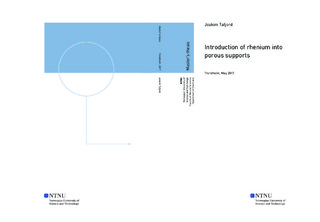| dc.description.abstract | This thesis is concerned with the synthesis of porous catalysts containing metallic rhenium nanoparticles. The goals of this work were to evaluate alternative introduction methods to the currently employed incipient wetness, and to evaluate the effect of different porous support properties, such as pore size and pore dimensionality. The porous support materials SAPO-34, AlPO-34, AlPO-5, SAPO-5 and SBA-15 were synthesized successfully. The synthesized phase-pure supports were subjected to introduction of rhenium(VII)oxide by two different procedures: ion-exchange and incipient wetness. The introduction through ion-exchange with ethanol as solvent was successfull for SAPO-34. However, this method did not achieve appreciable loadings for any of the other supports. Incipient wetness was performed on SAPO-34, SAPO-5 and SBA-15, and resulted in loadings over 2.3 wt.\%. Two different heat treatment programs were used for reduction. The first treatment was by direct reduction in hydrogen gas, while the second had a calcination step in air prior to reduction.
X-ray diffraction (XRD) was performed to verify phase-purity of the zeotypes, and also to detect rhenium phases. Surface measurements (BET, BJH) verified the surface area and validated the SBA-15 pore system, while elemental composition was analyzed by ICP-MS. Diffuse Reflectance Infrared Fourier Transform Spectroscopy (DRIFTS) investigated the presence of Brønsted acidity in SBA-15 samples synthesized with an aluminum precursor. Scanning Electron Microscopy (SEM) was used to image SAPO-34 before and after ion-exchange in ethanol. Ex situ XAS was performed to investigate the fraction of reduced rhenium and the metallic particle sizes. By comparing the resulting metallic rhenium particle size to the pore size of the support material, the success of growth limitations of rhenium were evaluated. Growth limitations were achieved for SAPO-34 and mesoporous SBA-15 with rhenium introduced through incipient wetness, followed by direct reduction. Metallic rhenium particles supported in SAPO-34 has not been reported before. The calcination step in the second heat treatment resulted in large rhenium mass loss for all samples. | |

